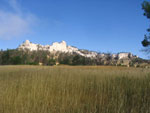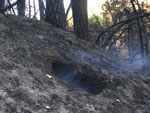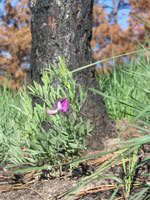
From 2004 to 2007, Tapestry was based at a ranch on the Pine Ridge of northwestern Nebraska. It was our land base, and we held meetings and workshops there. In the summer of 2006, a catastrophic wildfire burned through the canyon. While our houses were left intact, we were forced to leave the ranch in fall of 2007 because of the financial consequences of the fire. The Pine Ridge Hike blog entries discuss the fire and recovery of the canyon. They are meant to inform and educate, but also to honor our great land partner in this canyon of the Pine Ridge. We hope to someday have another land base to help us in our work of reconnecting people to nature. These entries are written by Tapestry’s President, Joanne (Jo) L. Belasco, Esq.
When we first moved to Nebraska’s Pine Ridge in early August, 2004, I was overcome with the beauty of the place. At the time, we had two other full-time Tapestry staff members, and they had actually been the ones to come look at it first in December of 2003. I saw it in pictures but I didn’t see it in person until we moved. When they returned from their trip to the ranch that December, I told them that as long as my animals were close to me, it would be home. Part of the beauty of the Pine Ridge was the forest. So many beautiful, green Ponderosa Pine trees. They evoked memories of me riding on trails in upstate New York as a child, with my late father walking beside me since we only had one horse. The smell of the pines after a rain was like inhaling Nature itself.
So, when the catastrophic wildfire of 2006 came, I, like the other Tapestry staff, was devastated. The beautiful pine forest was gone and in its place were black sticks and black ground. The smell of smoke and ash permeated everything. Walking outside my house, I could smell it every single day. I still remember, one day before the fire hit our ranch, driving down the gravel road and looking out over the forest thinking, “If the firefighters can’t control this fire, I won’t ever see this view again. All of those trees will burn.” Sure enough, that entire grove of trees was burned by the fire. I knew that there were too many trees. They were too small, too close together, from logging half a century earlier and overgrazing for years. But I still loved those trees and that forest.

Several days after the fire, I took a hike back into the woods because I could still see smoke. Once you have a wildfire, it doesn’t just go out. The fire burns for weeks or months. It burns in tree stumps. It burns in roots under the ground. I would bend down and feel the heat of the earth, as she literally burned underneath my hand. If I pushed away thick layers of ash with my boot, I might uncover a root, still burning, hot, white smoke rising into the air. I remember one tree that was still burning in the inside. There was no danger of it causing more destruction because all of the trees and grass around it were burned black. But the inside of that tree still contained a flame, and the smoke came out of it as if it were a living, breathing dragon.
I began to take pictures with our small, digital camera. Most catastrophic fires like ours (that burn through wilderness areas) burn on public lands and then the forest is closed to the public because of the danger of burning ground and falling trees. Here was a unique opportunity to capture images of the forest after a burn. Would it come back? Would there ever be grass and wildflowers again? Would it ever be green again or would it forever be black? Would all of the trees blow over in the winter wind? It wasn’t easy walking through that forest. So many trees just burned black. I’d come back from a hike and find black ash over my bare legs, even though I had been wearing jeans during the hike. At one point, I fixed a burned fence line and without even touching the ash, wound up with it all over my face and arms. White socks were permanently dyed gray and black, no matter the amount of washings.
What I learned through these images is that fire leads to rebirth and a beauty that is hard to find elsewhere. Many people in the area where the fire happened immediately logged the land, wanting to make money out of the ugliness they saw. But we did not. We knew that no amount of money was worth throwing Nature off balance. Fire is natural. That canyon needed the fire because it was being strangled from too many trees due to previous logging and overgrazing.

And so, when I could, I would go for a hike and take photographs. It is these pictures that I wish to share with you. Some people may say, “Why did you try to save a burnt canyon? Why didn’t you relocate immediately after the fire?” Many people in that area were surprised we stayed. But we stayed and would have continue to stay there because that land was special. There was a beauty there that arose because of the fire. The canyon could be seen again. Buttes made invisible by too many trees towered above us. The grasses grew rich and tall – up to my shoulders in some places. Yes, there were still places blackened from the severe burn. Yes, there were still many, many trees that were black sticks from the fire. But there was a beauty there. Look closely at those black trees, and you’d see silver bark, like liquid metal, from the heat of the fire burning the bark. I hope that my photos, sprinkled with comments, will show you that the canyon was special. It was worth saving. Not so Tapestry’s staff could enjoy its beauty, but because it was a place for people to come, to learn, to experience, and to share. The old, choking matter had been burned away, and now the canyon could breathe, could heal, could be what it should have been all along. Even though we are no longer there, we can join that healing. We can reconnect to the earth and in so doing, find a part of us that we thought we had lost forever. So, sit back and enjoy, as I take you on many hikes with me through our canyon ranch home of Nebraska’s Pine Ridge.
Let’s begin our hike…
Jo
